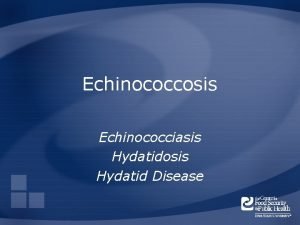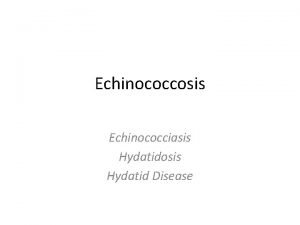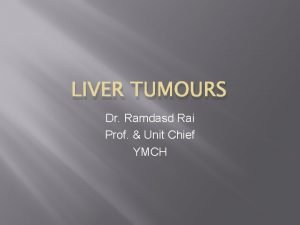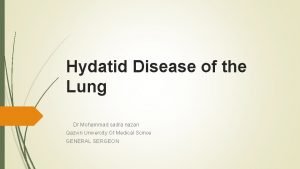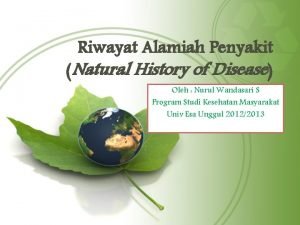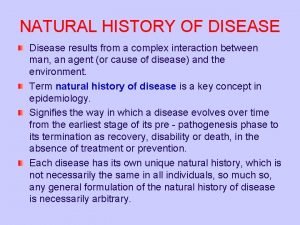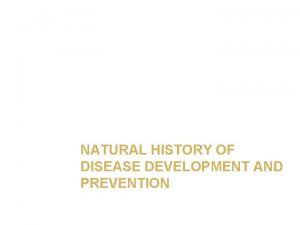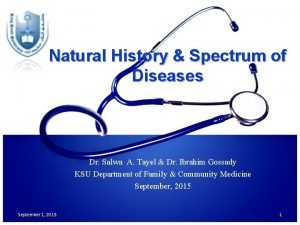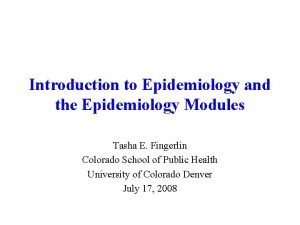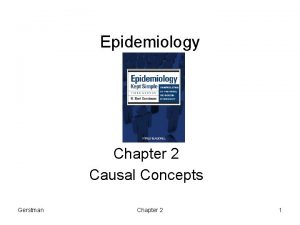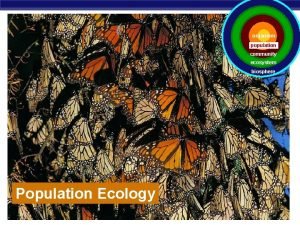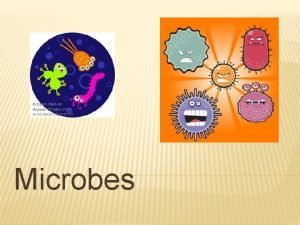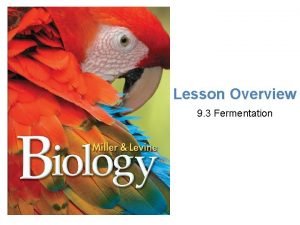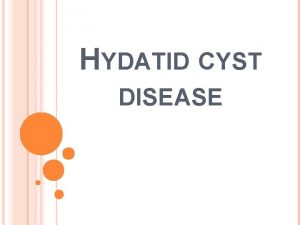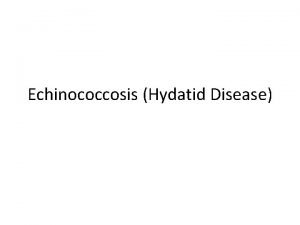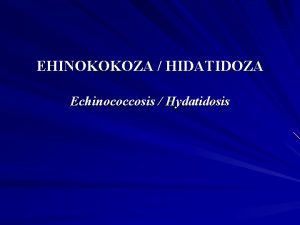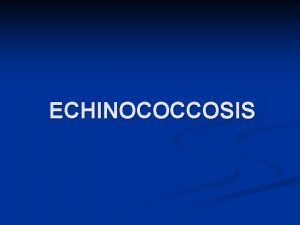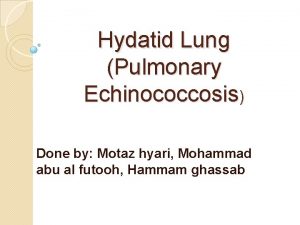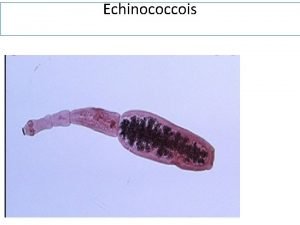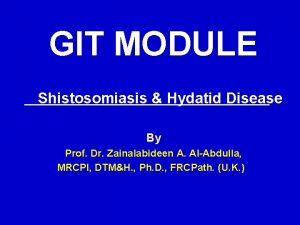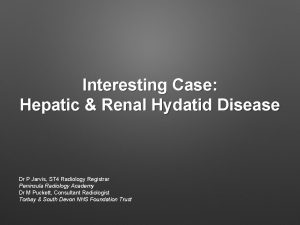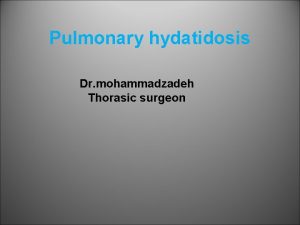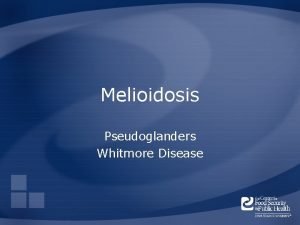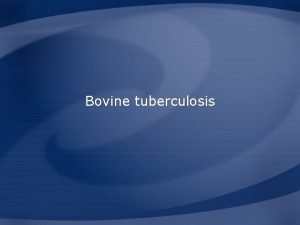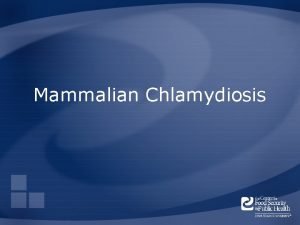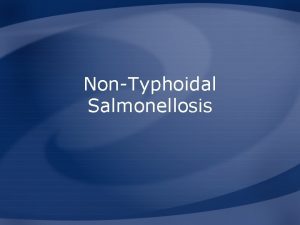Echinococcosis Echinococciasis Hydatidosis Hydatid Disease Overview Organism History






























- Slides: 30

Echinococcosis Echinococciasis Hydatidosis Hydatid Disease

Overview Organism History Epidemiology Transmission Disease in Humans Prevention and Control

The Organism • Echinococcus granulosus – Cystic echinococcosis – Unilocular echinococcosis – Cystic hydatid disease • Multiple species and strains • E. granulosus sensu lato – General term for all species and strains

The Organism Cestode parasites Family Taeniidae Currently recognized species Echinococcus granulosus Echinococcus multiocularis Echinococcus vogeli Echinococcus oligarthrus Echinococcus shiguicus


LIFE CYCLE



Hydatid cyst

E. granulosus Strains

The Organism • E. multilocularis – Alveolar echinococcosis – Alveolar hydatid disease – Multilocular echinococcosis – Multivesicular hydatidosis • Multiple strains – Less distinct than E. granulosa s. l. – E. shiquicus a distinct species?

Cont… • Echinococcus vogeli and Echinococcus oligarthrus – Polycystic echinococcosis – Unicystic echinococcosis

The Organism: Zoonotic Species G 1 (sheep strain) E. granulosus s. l. • Most frequent cause of disease in humans Other species may be important regionally

Epidemiology • E. multilocularis – Northern hemisphere • Eurasia, Europe, North America • E. vogeli, E. oligarthrus – Central and South America • E. shiquicus – China

Transmission • Indirect life cycle – Definitive hosts ingest cysts in tissues of intermediate hosts – Cysts develop into tapeworms – Gravid proglottids or eggs shed in feces by definitive host – Eggs ingested by intermediate hosts

Transmission: E. granulosus s. l. • Definitive hosts – Canids – Felids – Hyaenids • Intermediate hosts – Herbivores – Humans

Transmission: E. multilocularis • Definitive hosts – Wild carnivores (e. g. , fox) – Domestic dogs and cats • Intermediate hosts – Small mammals (rodents) – Domesticated mammals – Humans

Transmission • E. oligarthus – Definitive hosts • Wild felids – Intermediate hosts • Rodents • E. vogeli – Definitive hosts • Bush dogs • Domestic dogs – Intermediate hosts • South American rodent (e. g. , pacas)

Zoonotic Transmission • Humans act as intermediate hosts • Ingest tapeworm eggs shed by definitive hosts – Contaminated fruits, vegetables, herbs, water

Disease in Humans • Incubation period – Month to years – 20 to 30 years documented for cysts that grow slowly and are not in a critical location • Clinical signs – Depend on size, number and location of metacestodes

Disease in Humans: E. granulosus s. l • May be asymptomatic • Usually one cyst present • Cyst location – 60 to 70% in liver – 20 to 25% in lungs • Symptoms dependent on cyst location

Disease in Humans: E. multilocularis • Cysts usually found in liver • Cysts not enclosed within membrane – Invade surrounding tissues – Disease is progressive and malignant • May be asymptomatic if cyst dies early in development

Disease in Humans: E. vogeli, E. oligarthrus • Cysts usually originate in liver – Can spread to nearby organs/tissues • Symptoms dependent on cyst location

Diagnosis • Imaging techniques – Ultrasound, radiology, MRI, CT • Serology enzyme-linked immunosorbent assays (ELISAs), indirect immunofluorescence, indirect hemagglutination, immunoblotting and latex agglutination. • Biopsy • Detection of protoscolices – Cyst fluid, sputum • PCR

Treatment • Cysts are often removed surgically. • Success rate varies with the species of Echinococcus and the location and size of the cyst(s). • E. multilocularis or E. vogeli infections, it may not be possible to remove the entire cyst. • Long-term post-surgical treatment with antiparasitic drugs such as albendazole or mebendazole may shrink or destroy the organism, help prevent it from regrowing and/ or ameliorate the symptoms

Treatment • Another treatment option is the removal of most of the cyst contents and the introduction of an anthelminthic chemical into the cyst under ultrasonographic guidance (PAIR puncture, aspiration, injection, and reaspiration).

Prevention and Control • Control echinococcosis in domestic animals – Don’t feed livestock entrails to dogs – Don’t allow dogs and cats to hunt – Regularly test and/or treat animals allowed outside

Prevention in Humans • Minimize risk of egg ingestion – Wash fruits and vegetables – Wash hands frequently – Avoid untreated water sources – Do not handle wild carnivores or their carcasses – Thoroughly cook meat before eating

Cont…. • Wear personal protective equipment • Regular surveillance – Laboratory personnel – Children exposed to feces of infected animals • No vaccine

Prevention in Animals • Regular surveillance • Treat infected animals (dogs) – Praziquantel – Multiple doses required • Vaccination – Recombinant
 Echinococciasis
Echinococciasis Echinococciasis
Echinococciasis Gravid segment
Gravid segment Cestodlar
Cestodlar Hydatid thrill three finger test
Hydatid thrill three finger test Pair for hydatid cyst
Pair for hydatid cyst Hydatid cyst
Hydatid cyst Food chain
Food chain Bharathi viswanathan
Bharathi viswanathan Natural history of disease adalah
Natural history of disease adalah Natural history of disease
Natural history of disease Natural history of disease diagram
Natural history of disease diagram Natural history of disease is best studied by
Natural history of disease is best studied by Natural history and spectrum of disease
Natural history and spectrum of disease Tasha introduction
Tasha introduction Natural history of disease
Natural history of disease History also history physical
History also history physical Diagram of unicellular organism
Diagram of unicellular organism Multicellular organism meaning
Multicellular organism meaning Give the example of multicellular organisms
Give the example of multicellular organisms Travelers diarrhea organism
Travelers diarrhea organism What is a transgenic organism apex
What is a transgenic organism apex Family solanaceae classification
Family solanaceae classification An organism that makes its own food *
An organism that makes its own food * Name the picture
Name the picture Biology taxonomy tree
Biology taxonomy tree What is a photosynthetic organism
What is a photosynthetic organism Organism population community ecosystem biosphere
Organism population community ecosystem biosphere Microscopic organism definition
Microscopic organism definition Organism
Organism Draft horse organism classifications
Draft horse organism classifications
